We explore the oily threat to Tuna and a newly discovered way that blood vessels in the brain clear a blockage in this Naked Scientists NewsFlash. Plus, how channels on Mars reveal secrets about the Martian climate, and the fossil evidence that shows the octopus is older than expected. We find out why shape is essential for H. plyori - a gut bug associated with ulcers and cancer.
In this episode
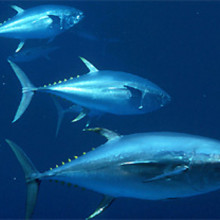
00:17 - Good and bad news for bluefin tuna
Good and bad news for bluefin tuna
New research pinpoints the favourite breeding spots of west Atlantic bluefin tuna in the Gulf of Mexico spelling both good and bad news for these imperilled fish: conservation efforts now know where to target efforts but the bluefins' spawning grounds overlap with the recent Deepwater Horizon oil spill potentially putting them in even more trouble.
 Using a combination of data on where tuna are caught by fisheries and studies that have tagged and tracked individual tunas, Steven Teo from the University of California Davis and Barbara Block from Stanford University, both in the US, built a computer model that accurately predicted where bluefins are likely to spawn based on oceanographic data gathered by satellites and weather buoys.
Using a combination of data on where tuna are caught by fisheries and studies that have tagged and tracked individual tunas, Steven Teo from the University of California Davis and Barbara Block from Stanford University, both in the US, built a computer model that accurately predicted where bluefins are likely to spawn based on oceanographic data gathered by satellites and weather buoys.
Their study, published in the journal PloS ONE showed that bluefins have a strong preference for spawning in two particular hotspots in the Gulf, where there are circular, swirling water masses called cyclonic eddies. These are cooler and more nutrient rich than warmer currents around the Gulf.
In contrast, the more common yellowfin tuna spawn throughout the Gulf and are more tolerant than bluefins to a range of environmental conditions including temperature.These differences between the two species probably come down to the bluefins' much larger size - they can grow up to 4 metres compared to yellowfins, which never exceed 2 metres. Increased activity during spawning times means bluefins can easily get heat stressed so water temperature is critical. Bluefin larvae may also be more reliant on high levels of nutrients in the water than yellowfin larvae.
All this is vital information for protecting bluefins, which have undergone serious declines since the 1970s of over 80% due to overfishing for sushi. Despite a ban on directed fishing of bluefins in the Gulf their numbers have yet to recover possibly because they are still caught accidentally by boats targeting yellowfins.
This study should make it much easier for fisheries and enforcement officers to use oceanographic data to work out where and when bluefins are likely to spawn. If a yellowfin fleet finds itself in an area where bluefins could be spawning they can pull their longlines in and move elsewhere.
Unfortunately, these bluefin spawning hotspots coincide with parts of the Gulf of Mexico at risk from the recent oil spill. We won't know for sometime how badly this will impact future generations of bluefins, which already have enough problems to deal with.
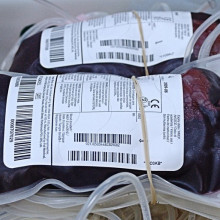
04:03 - Brains bust blood clots
Brains bust blood clots
Cells lining blood vessels in the brain can grab clots and other obstructions and dump them outside the vessel to restore blood flow, US researchers have found.
In a paper in Nature, Northwestern University scientist Carson Lam and his colleagues use a clever imaging technique (called two photon imaging) to watch what happens when fluorescently-labelled blobs of cholesterol are released into the blood vessels supplying the brains of mice. To their surprise, whenever the glowing balls of fat lodged in a small blood vessel, blocking it, within a few days it had been cleared and was sitting outside the blood vessel, almost as though a snow-plough had pushed it out of the road like a snow drift.
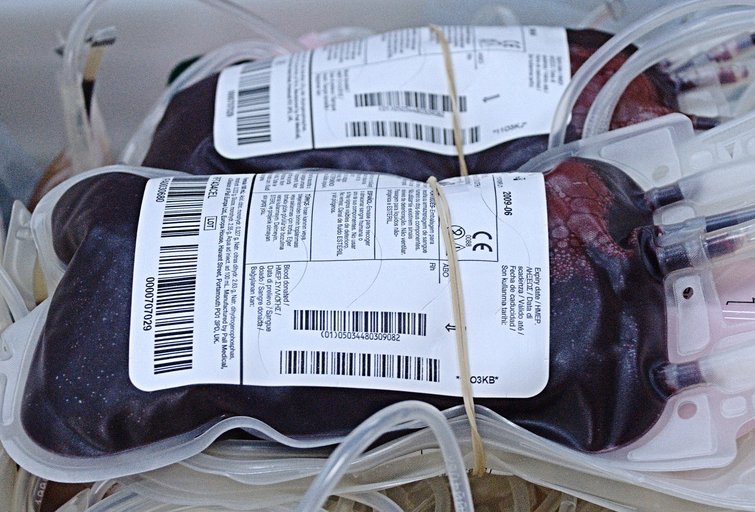 A closer look at how the process was taking place revealed that the endothelial cells, which form the linings of blood vessels, were orchestrating a sequence of events never seen before.
A closer look at how the process was taking place revealed that the endothelial cells, which form the linings of blood vessels, were orchestrating a sequence of events never seen before.
The cells were putting out thin extensions of their membranes and completely enveloping the obstruction before opening up a channel between them and their neighbours and ejecting the material from the inside of the vessel. Interestingly, when the team compared this behaviour in young versus older mice, they found that it was much less efficient with increasing age and there was considerably more brain injury as a result in these older animals.
This might help to explain in part, say the researchers, why humans succumb to deteriorating brain function as we age. At the same time it might also account for the observation that diseases like diabetes and high blood pressure - which can make the walls of small vessels much thicker - tend to increase the risk of stroke and dementia, perhaps because blood vessels damaged in this way find it more difficult to unblock themselves, leading to neuronal loss.
Clearly it's early days yet, but getting to the bottom of this observation could open up new avenues in brain protection and repair.

06:51 - Martian Grooves Reveal Climate Secrets
Martian Grooves Reveal Climate Secrets
Astronomers studying enigmatic grooves on the surface of Mars have uncovered secrets about the planet's historic climate. In a paper published in Nature this week, Isaac Smith and John Holt of the University of Texas Institute for Geophysics analyse new radar images of the grooves taken by the American Mars Reconnaisance Orbiter and the European Mars Express spacecraft, and they've found that beneath each of the grooves, there are indentations in all of the stratified layers of deposit down to a depth of almost 700 metres.
 That was a startling result, because many people had thought these were merely scratch-like features carved out by erosion, extending down to a few tens of metres. We can now discard those theories as they have no way of explaining why the sub-surface geology is as much affected as the surface. A much better theory is that there is some finely-balanced combination of wind erosion and deposition at work, which is keeping the troughs remarkably stable and well-preserved as new layers of material are laid down on top of them. If that is right, then it's possible to guess the age of the features, assuming that material is deposited at a rate of around a millimetre per year, and the answer is that they must be between 500,000 and two million years old.
That was a startling result, because many people had thought these were merely scratch-like features carved out by erosion, extending down to a few tens of metres. We can now discard those theories as they have no way of explaining why the sub-surface geology is as much affected as the surface. A much better theory is that there is some finely-balanced combination of wind erosion and deposition at work, which is keeping the troughs remarkably stable and well-preserved as new layers of material are laid down on top of them. If that is right, then it's possible to guess the age of the features, assuming that material is deposited at a rate of around a millimetre per year, and the answer is that they must be between 500,000 and two million years old.
That is fascinating, because it's potentially telling us about Martian weather systems not just today, but hundreds of thousands of years ago. Smith & Holt have looked at various possible wind-driven processes which could be responsible for the grooves, and find that quite a complicated cocktail of wind erosion and particle transport is needed to keep the troughs in a steady equilibrium. Given the delicacy of the conditions required, the findings seem to preclude any recent climate change on Mars.
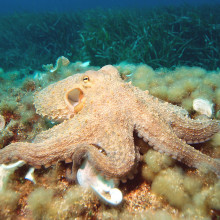
09:08 - Octopus and squid more ancient than we thought
Octopus and squid more ancient than we thought
A new fossil study reveals that the ancient ancestors of octopuses, squid, and cuttlefish have been swimming through the oceans for at least 30 million years longer than previously thought.
Originally only a single fossil of a mysterious creature named Nectocaris pteryx was found in the famous Burgess Shale deposits in Canada. And for a long time researchers were stumped as to what kind of animal it was.
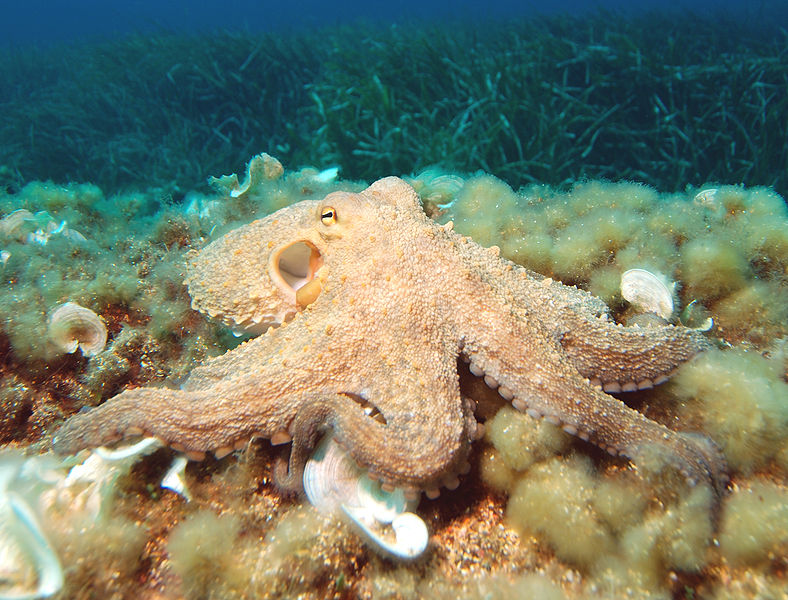 Now, writing in the journal Nature, Martin Smith from the University of Toronto leads a study that reveals a series of key characteristics that tie Nectocaris to the group of molluscs, including octopuses and squid, known as cephalopods.
Now, writing in the journal Nature, Martin Smith from the University of Toronto leads a study that reveals a series of key characteristics that tie Nectocaris to the group of molluscs, including octopuses and squid, known as cephalopods.
Over 90 new specimens have been found of the tiny creatures that were between two to four centimetres long. They had large, stalked eyes and a long pair of grasping tentacles, which they probably used to hunt for and eat prey. The researchers think they used jet propulsion to push themselves along by forcing water through a nozzle-like funnel, like many modern cephalopods do today.
Nectocaris evolved around 500 million years ago, not long after the so-called Cambrian explosion when a plethora of complex, multicellular life emerged over a short period of time setting the stage for the evolution of many groups of animals still around today.This study changes the commonly held view of the cephalopods not only because it pushes back the date when they first evolved, but it also offers insight into how they evolved into other modern and extinct forms. Nectocaris had no hard shell and it swam actively around the ocean, which goes against theories that cephalopods first evolved from ancient, bottom-dwelling molluscs with heavy, hard shells which later evolved into the floating devices found inside other cephalopods, the extinct ammonites and living chambered nautilus.
Many questions still remain about Nectocaris and the beginnings of the cephalopods but we now have a much clearer picture of what was going on 500 million years ago. We even know how some of these Nectocaris creatures died: their gills are choked in fine deposits, telling us they were probably buried in an underwater mudslide.
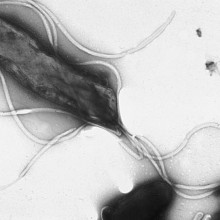
11:53 - Shape matters for Helicobacter infection
Shape matters for Helicobacter infection
Dr Nina Salama, Fred Hutchinson Cancer Reserach Centre, Seattle
Chris - Also in the news this week, researchers in Seattle have discovered that at least as far as gut bugs go, you have to be the right shape to be a success. We knew that size was important in some context. Shape now turns out to be equally so. The bacteria in question is Helicobacter pylori and this bacteria lives in our digestive system, and it's also been linked to the formation of stomach ulcers and stomach cancer. Now intriguingly, it has a very distinctive spiral shape which scientists have thought was what helped the bacteria to survive and also move around in the gut. The new research has now shown that the spiral bacteria definitely do a lot better than if we straighten them out and make mutant forms that don't have that spiral shape. And so this suggests there might be a clue there as to new ways that we can fend off this infection. And joining us to explain how they've discovered this, from the Fred Hutchinson Cancer Research Centre in Seattle is Dr. Nina Salama. Hello, Nina.
Nina - Hello.
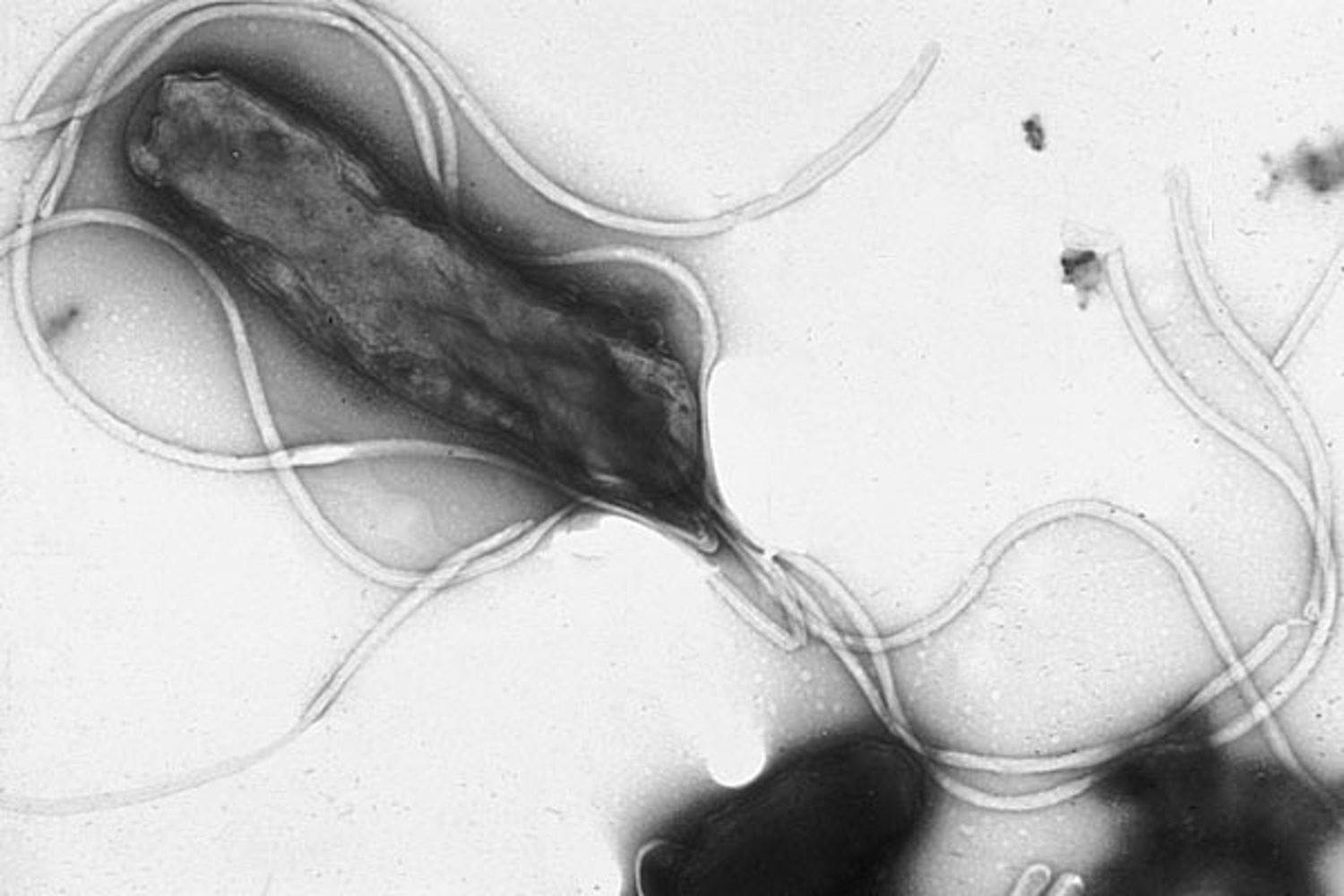 Chris - Welcome to the Naked Scientists. Tell us, if you would first of all, what is H. pylori in a little bit more detail than I went into and how does it cause disease?
Chris - Welcome to the Naked Scientists. Tell us, if you would first of all, what is H. pylori in a little bit more detail than I went into and how does it cause disease?
Nina - Well, Helicobacter pylori is a bacterium that lives in the stomach and when it was discovered in the early '80s by Barry Marshall and Robin Warren from Australia, their finding was pretty revolutionary because people thought that no bacteria lived in the stomach because of its high acidity. But these bacteria live in this very thick mucus that protects our stomach cells from the acid in the lumen and these scientists cultured them from patients with ulcers because as you say, this bacterium is associated with the development of ulcers. But it turns out that about half of the world carries this bacteria in their stomach and what it does is it causes inflammation. Most people survive with this inflammation and aren't bothered by it, but some people will get ulcers and then a smaller number of people can actually get gastric cancer, and Helicobacter pylori is the only bug at this point listed as a carcinogen by the World Health Organization.
Chris - So obviously, finding ways to make it less likely that a person will become colonised and carry the bug would be very, very helpful because it means that then there'd be less prospect of at least some people developing those stomach pathologies that you mentioned. But tell us about the shape of the bacterium.
Nina - Well as you say, Helicobacter pylori, sort of evident in its name is a helical rod shape bacteria. It looks kind of like a spiral and what we wanted to ask was whether shape really was important for it to be able to colonise in its niche, the stomach mucosa. So, what we did was look for mutant forms of the bacteria; bacteria where individual genes had been inactivated that now had lost normal shape. And interestingly, we found quite a number of different bacteria inactivated in different genes, indicating that the bacteria have a whole program to enact this shape. So the study that we just published analysed four genes that seem to work together to make this normal helical shape by modifying the cell wall and basically taking this cage which wraps around the bacteria, and gives it its shape by making little snips in that cage to make it more flexible so that it can turn into this helix and have the appropriate twist and curvature to make the helical shape.
Chris - So the obvious thing to do is to identify what those genes are, then you can go in and deactivate them. What happens to bacteria if you switch off the genes that normally make them like a cork screw shape?
Nina - It's kind of interesting. If we grow them in the lab in broth, they are just fine being grown normally, they swim normally, and they appear to be no more sensitive to stresses like acid or some of the defence molecules that our bodies secrete to kill bacteria. They seem to be just fine. But if we take them now and try to infect them into the mouse stomach because that is the model that we use since we don't do experiments on humans. Now, these strains with an abnormal shape cannot colonise the stomach.
Chris - Do you know why?
Nina - That is a really good question. We don't know exactly why. So, the previous idea in the field was that it might help with motility - the ability of the bacteria to swim out of the acid part of stomach in the lumen, down into this mucus layer and next to the cells. But what we found is that they appear to swim normally, both in regular broth and in conditions where we make a gel-like matrix to mimic the thick mucus gel that overlies our stomach and we watched the bugs by live video microscopy. We basically can't find any differences in velocity. So now, we're left to try to figure this out. So the good news is that we have this animal model where we can see a difference in the way the bacteria colonise. And so now, we're trying to go in and look where the bacteria go, how that differs from the normal spiral shaped bacteria, and try to get to the bottom of it.
Chris - And finally, Nina presumably, because you found that these genes, if they're not working and you know how they work which is helpful, they seriously disable the bug. This presumably means you can now start to look for potential drugs that could target those genes and the things that those genes make because that might be a new way to treat or potentially disable them and decolonise people who are carrying H. pylori?
Nina - Yes. In fact, a very exciting thing about our findings, is that three of the four proteins that our work uncovered appear to have a very specific biochemical activity, and that they can cleave a peptide bond. And so, having an enzyme as it were, that's functioning in your process makes it a real possibility for screening for inhibitors of these enzymes that presumably then could render the bacteria unable to colonise. And another good thing is that these enzymes aren't found in human cells so that's the other trick when you try to develop a drug against bacteria. You want something that's specific to the bacterium but that's not going to hurt our own cells.
Chris - So you can make it highly selective. Nina, thank you very much. We have to leave it there. Dr. Nina Salama from the Fred Hutchinson Cancer Research Centre in Seattle. She's published that work this week in the journal Cell.










Comments
Add a comment